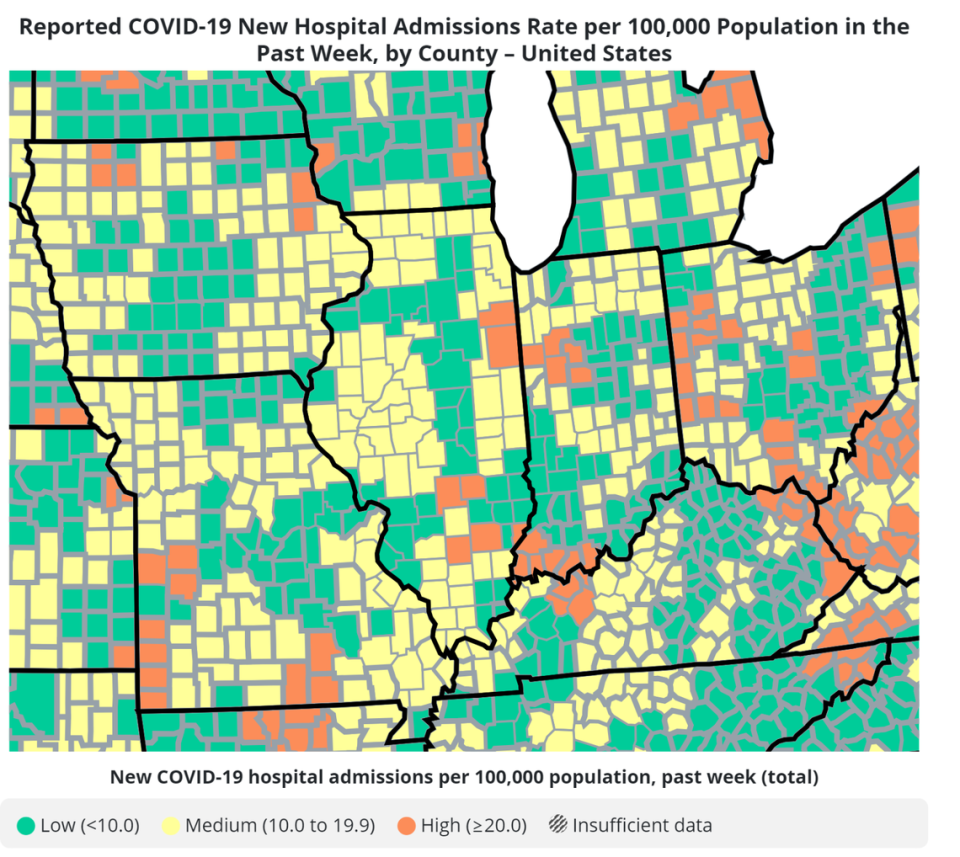Hospitalizations elevated in 54 Illinois counties. What to know about risk of long COVID
More than half of Illinois counties are at elevated levels for COVID-19 hospitalizations, according to a Friday press release from the state’s public health department.
Fifty Illinois counties are at medium COVID-19 hospitalization levels, while four are at a high level, the U.S. Centers for Disease Control and Prevention reports.
The Land of Lincoln has seen hospitalizations increase by approximately 28% to 30% over the last four weeks, Dr. Vidya Sundareshan, infectious diseases specialist with Southern Illinois University Medicine and medical advisor to Sangamon County Department of Public Health, told the News-Democrat recently.
“We are definitely seeing an increase in COVID cases,” Sundareshan said.
St. Clair, Madison, Monroe, Bond and Clinton counties are at a low level, and Washington, Marion, Macoupin, Montgomery and Greene are among the medium-level counties. Jefferson, Wayne, Wabash, Fayette, Effingham, Iroquois and Kankakee counties are at a high hospitalization level.

While the CDC recommends people who develop COVID-19 or are exposed to it to take precautions for 10 days after, some will experience symptoms for months or even years. Here’s what to know about long COVID, which is also referred to as post-acute COVID and chronic COVID, in Illinois.
What is long COVID, and how common is it?
Generally, a medical professional may consider a patient’s symptoms to be caused by long COVID if they are experiencing new or persisting symptoms four weeks after infection, Sundareshan said.
Long COVID is not one specific illness, the CDC says, and there’s no test available that can tell you whether the symptoms you’re experiencing are being caused by long COVID.
Some of the most common long COVID symptoms include brain fog, fatigue, chronic respiratory illness, new onset of diabetes and gastrointestinal problems. Fever, shortness of breath, heart palpitations and headaches are among the other possible symptoms, though long COVID can present itself in a variety of ways.
Loss of taste and smell was common in patients with long COVID contracted from the original coronavirus strands, Sundareshan said, but isn’t as prevalent with the newer variants.
A “significant percentage” of people who have been infected with COVID-19 develop postural orthostatic tachycardia syndrome, or POTS, within six to eight months of infection, according to the U.S. National Library of Medicine. POTS symptoms can include fatigue, brain fog and quickening heart rate with minimal physical activity, among others.
While developing POTS can be associated with long COVID, it is a separate syndrome that has been reported for decades and affects an estimated 500,000 to 1 million U.S. residents, according to a 2020 article from the Texas Heart Institute Journal.
Long COVID symptoms can go away and come back. Some individuals get slightly better over time, while others don’t. About 75% of people who experience COVID-19 symptoms for six months or longer post-infection end up with permanent symptoms, Sundareshan said.
Sundareshan said she has seen some patients struggle with long COVID symptoms for roughly three years, and many people’s symptoms can feel better or worse depending on the day.
At least 65 million people across the globe were estimated to have long COVID as of January 2023, according to Nature Reviews Microbiology, a peer-reviewed journal. Estimates vary on exactly how likely a person who is infected with COVID-19 is to develop long COVID, but Sundareshan said the number is probably somewhere between 10% to 20% of all patients who get COVID.
“We do look at most of the chronic medical conditions and immunocompromising conditions as risk factors for COVID, but anybody can develop post-COVID,” Sundareshan said.
Illinois officials recorded 4,139,537 COVID-19 cases in the state as of May 2023, but the actual number of infections is likely much higher.
A study published in The Lancet Jan. 11 found “Vaccination against COVID-19 consistently reduced the risk of long COVID symptoms,” according to data out of Spain, the United Kingdom and Estonia.
Sundareshan said she recommends people get vaccinated against COVID-19 to mitigate their chances of infection and suffering from long COVID.

